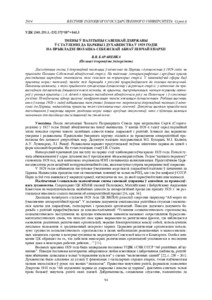Please use this identifier to cite or link to this item:
https://elib.psu.by/handle/123456789/1576| Title: | Змены ў палітыцы савецкай дзяржавы ў стаўленні да Царквы і духавенства ў 1929 годзе на прыкладзе Полацка-Себежскай абнаўленчай епархіі |
| Authors: | Бараненка, В. В. |
| Issue Date: | 2014 |
| Publisher: | Полоцкий государственный университет |
| Citation: | Вестник Полоцкого государственного университета. Серия A, Гуманитарные науки: научно-теоретический журнал. – Новополоцк: ПГУ, 2014. - № 1. - С. 94-98. |
| Abstract: | Даследуюцца змены ў дзяржаўнай палітыцы ў адносінах да Царквы і духавенства ў 1929 годзе на прыкладзе Полацка-Себежскай абнаўленчай епархіі. На падставе гістарыяграфічных і архіўных крыніц разглядаецца царкоўнае становішча, якое склалася на тэрыторыі епархіі. У заканадаўчай сферы быў прыняты шэраг пастаноў, пводле якіх барацьба з рэлігіяй прыраўноўвалася да класава-палітычнай. Паказаны цяжкасці, з якімі прыйшлося сутыкнуцца духавенству і веруючым епархіі: у адносінах да праваслаўнага духавенства ўжываліся такія метады, як арышты, дыскрэдытацыя, частыя пераводы святароў у розныя прыходы і г.д. Адной з прычын паслаблення абнаўленчага руху на Полаччыне і ў сумежных рэгіѐнах Пскоўшчыны аўтар вылучае канфрантацыю паміж мясцовым духавенствам. Робіцца выснова, што ў канцы 1920-х гадоў адбываецца паступовае ўзмацненне жорсткасці дзяржаўнай палітыкі ў адносінах да Царквы, надыходзіць працяглы этап сістэматычных ганенняў. Дзякуючы вынікам праведзенага даследавання ў навуковы зварот уводзіцца шэраг новых архіўных дакументаў, што з’яўляецца важным момантам для далейшых даследаванняў па гэтай тэме. = The author of the article studies changes in public policy towards the Church and the clergy in 1929 by the example of Polotsk-Sebezh renovationist diocese. On the basis of historiographic and archival sources the author studies the prevailing situation on the territory of the diocese. In the legislative sphere a number of regulations were adopted, according to which the struggle against religion was equal to class-political one. The clergy and the faithful of the diocese met a lot of difficulties: different kinds of punishment were inflicted on Orthodox clergy – arrests, defamation, frequent transfers of priests to different parishes, etc. The author depicts one of the reasons for the weakening of renovationist movement in Polotsk and adjacent Pskov regions – confrontation between local clergy. The author makes a conclusion that at the end of the 1920s there was a gradual growth of cruelty in public policy towards the Church, there also came a long period of systematic persecutions. The article introduces a new set of archival documents, and this is an important point for further research on this topic. |
| Keywords: | Исторические науки епархии священники православное духовенство |
| URI: | https://elib.psu.by/handle/123456789/1576 |
| metadata.dc.rights: | open access |
| Appears in Collections: | 2014, № 1 |
Items in DSpace are protected by copyright, with all rights reserved, unless otherwise indicated.
